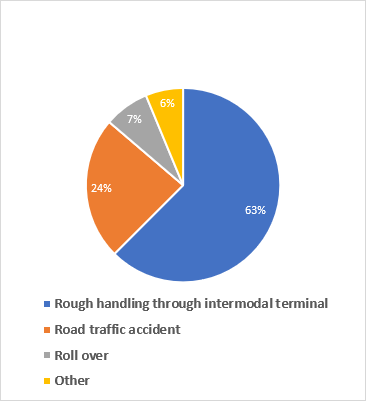TT Club’s analysis of 2020 claims points to an increase in impact related incidents, with corrosion of tank containers’ inner surface and contamination caused by cargoes previously carried as significant other causes of loss.
The analysis makes clear that the effects of increased volumes of tank containers used to trade chemicals and other liquids on the primary east-west trades have altered, to a degree, the risk profile of damage to such units. While in previous years there has been a consistent dominance of contamination as the major source of losses for tank container operators, the current figures show impact incidents as the foremost causation.
The primary causal types reported in the TT analysis account for over 80% of the incidents notified. They are: impact at 36%; internal pitting (from corrosion) accounting for 27% and contamination with an 18% share. The regional breakdown of total claims follows broadly the pattern of the trades on which tank containers are employed: 50% in Asia-Pacific; Europe at 36% and 13% occurring in the Americas.
International freight transport insurance specialist TT Club insures over 50% of the global tank container fleet. The data generated in its latest analysis of notified claims covers the 2020 policy year and is seen as a reliable representation of the risks faced by those businesses worldwide that operate tank containers.
TT’s Managing Director Loss Prevention, Mike Yarwood comments on the findings of the analysis, “The most significant trend we see is the relative increase in claims originating from impact incidents and from pitting of the tank’s internal steel surface. Historically we have experienced higher levels of contamination-related claims,” he says. “The increased occurrence of impacts involving tanks would seem to be a factor of higher container volumes handled at maritime and intermodal terminals. The pie chart breaking down our data below shows some 63% of impact incidents occurring at these locations. Volume increases at terminals, and associated congestion puts additional pressure on operators of handling equipment to achieve greater throughput levels. This effect, exacerbated by many tanks being ‘super-heavy’, has elevated risk.”
Road traffic accidents are the second highest cause of impact damage to tank containers with a higher proportion occurring in the Americas (almost 50%) despite this region accounting for only 21% of total impact-related damage incidents. Of those claims involving pitting damage, an overwhelming proportion occurred in Asia (87%), and the majority involved hazardous material (59%). Yarwood comments, “While there is a plethora of potential causes for this damage, there is currently no identifiable trend causing the increase in claim frequency. It would however be prudent for operators to be mindful of this exposure; ensuring where possible tanks are prioritised for cleaning once in an ‘empty dirty’ state and considering more regular inspections.”

The lower incidence of contamination evident in the current analysis compared with previous years can also be explained by the increased volumes of trade, capacity restrictions and the beginning of serious congestion experienced in recent years. Yarwood once more explains. “An assumption that one could reasonably reach, given the supply chain constraints, is that consignees are arguably more willing to accept cargoes, even where they suspect a negligible contamination issue, on the basis that replacing the product from its supplier could be complex and time consuming.”
TT Club’s Loss Prevention service is extensive and regular alerts and StopLoss documents are issued to assist operators to reduce their risk and avoid time-consuming claims. For more information, please visit TT’s Loss Prevention webpage or for specific tank container information, read TT’s Tank Container StopLoss and latest alert relating to the classification of divinylbenzene.
About TT Club
TT Club is the established market-leading independent provider of mutual insurance and related risk management services to the international transport and logistics industry. TT Club’s primary objective is to help make the industry safer and more secure. Founded in 1968, the Club has more than 1100 Members, spanning container owners and operators, ports and terminals, and logistics companies, working across maritime, road, rail, and air. TT Club is renowned for its high-quality service, in-depth industry knowledge and enduring Member loyalty. It retains more than 93% of its Members with a third of its entire membership having chosen to insure with the Club for 20 years or more.






